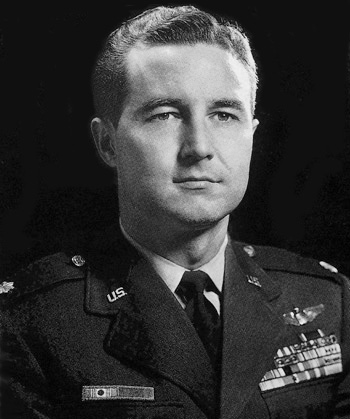
|
Ralph S. Parr, Jr. |
 |
|||
| Rank, Service | ||||
Colonel O-6, U.S. Air Force |
||||
| Veteran of: | ||||
|
||||
| Tribute: | ||||
Ralph Parr was born on July 1, 1924, in Portsmouth, Virginia. He enlisted in the U.S. Army Reserve on November 4, 1942, and he was accepted into the Aviation Cadet Program on February 2, 1943, earning his pilot wings and commission as a 2d Lt in the U.S. Army Air Forces at Maxwell Field, Alabama, on February 8, 1944. His first assignment was as an instructor pilot at Blytheville, Arkansas, from February to September 1944, followed by P-38 Lightning transition training from October 1944 to April 1945. Lt Parr served as a P-38 pilot in various bases in California from April to August 1945, and then served as a P-38 and then P-51 Mustang pilot with the 7th Fighter Squadron of the 49th Fighter Group on Okinawa and then in Japan from August to July 1946. After returning to the U.S., he left active duty and joined the Air Force Reserve on September 3, 1946, but was recalled to active duty on February 9, 1948. After returning to active duty, Capt Parr served as a P-51 and then F-84 Thunderjet pilot with the 60th Fighter Squadron at Walker AFB, New Mexico, and then at Otis AFB, Massachusetts, from February 1948 to July 1950. He then served as an F-80 Shooting Star pilot with the 7th Fighter Bomber Squadron at Furumaki AB, Japan, and then deployed to Korea from July 1950 to May 1951, followed by service as an F-86 Sabre pilot with the 116th Fighter Interceptor Squadron at Geiger Field, Washington, from June to August 1951, and with the 94th Fighter Interceptor Squadron at George AFB, California, from August 1951 to May 1953. Capt Parr returned to Korea as an F-86 pilot with the 335th Fighter Interceptor Squadron from May to September 1953, and was credited with destroying 10 enemy aircraft in aerial combat during the last 7 weeks of the war, including being credited with the last aircraft shot down of the Korean War. He then served with the 334th Fighter Interceptor Squadron in Korea from September 1953 to February 1954, followed by service as an F-86D Sabre Dog air defense pilot with the 4750th Air Defense Group at Vincent AFB, Arizona, from February 1954 to July 1958. Maj Parr served as an Operations Staff Officer with the 73rd Air Defense Division at Tyndall AFB, Florida, from July 1958 to October 1959, and then as an Operations Staff Officer with the Military Assistance and Advisory Group in the Netherlands from October 1959 to September 1962. His next assignment was as an Operations Staff Officer with the 836th Air Division at MacDill AFB, Florida, from September 1962 to January 1963, followed by service as Operations Officer for the 4453rd Combat Crew Training Squadron at MacDill AFB from February to December 1963. Col Parr then served as Commander of the 4456th Combat Crew Training Squadron at MacDill AFB from January to July 1964, and then as Operations Officer for the 4454th Combat Crew Training Squadron at Davis-Monthan AFB, Arizona, from August 1964 to January 1965. He served as Commander of the 4455th Combat Crew Training Squadron at Davis-Monthan AFB from January 1965 to August 1966, and then attended Air War College at Maxwell AFB, Alabama, from August 1966 to August 1967. Col Parr then served as Deputy Commander for Operations of the 12th Tactical Fighter Wing at Cam Ranh Bay, South Vietnam, from September 1967 to August 1968, followed by service as on the staff of the Military Personnel Group at Randolph AFB, Texas, from October 1968 to March 1970. His next assignment was as Vice Commander of the 12th Tactical Fighter Wing at Phu Cat AB, South Vietnam, from March to October 1970, and then as Commander of the 12th Tactical Fighter Wing from October 1970 to April 1971. Col Parr served on the staff at Headquarters U.S. Air Forces in Europe at Lindsey AS, West Germany, from April 1971 to August 1972, and then with the Military Assistance and Advisory Group to Iran from August 1972 to January 1974. His final assignment was as Director of Operations for the Tactical Air Warfare Center at Eglin AFB, Florida, from January 1974 until he was medically retired from the Air Force on October 17, 1976, after a serious back injury from inspecting hurricane damage to a roof at the base. Col Parr is the only person ever awarded both the Distinguished Service Cross and the Air Force Cross. In addition, he accumulated over 8,000 flying hours in fighters and flew 641 combat missions in three wars. Ralph Parr died on December 7, 2012, and was buried at the Fort Sam Houston National Cemetery in San Antonio, Texas. |
||||
|
||||

